“Miri”
Written by Adrian Spies
Directed by Vincent McEveety
Season 1, Episode 11
Production episode 6149-12
Original air date: October 27, 1966
Stardate: 2713.5
Captain’s log. The Enterprise picks up an Earth-style SOS from a planet that is a dead ringer for Earth. Kirk beams down along with Spock, McCoy, Rand, and two security guards. They find abandoned buildings and vehicles, but no life. They find a tricycle, and McCoy futzes with it—only to be attacked by a scab-covered creature. Kirk and Spock manage to subdue him, and then he starts crying because the tricycle is broken. The creature has a seizure and dies. McCoy’s readings indicate that his biochemistry is acting like he’s aged a century in a few minutes.
They hear noises in a building, so they investigate. They check a closet, where Kirk—while standing with a phaser surrounded by several other people with phasers—says to come out because they mean no harm. They find a young woman named Miri in the closet, crying, begging them not to hurt her.
Kirk, Rand, and McCoy care for Miri while Spock and the security guards check outside. Miri is scared to death of “grups,” and she assumes that the landing party are grups also. They started to get sick, and then they died—but the “onlies,” the children, are still alive.
Sure enough, Spock and the guards hear a bunch of kids taunting them, though they can’t locate them. He reports that to Kirk, who asks Miri where the doctors worked. She’ll show him, but she thinks that’s a bad place—and then she notices a lesion on Kirk’s hand. He’s getting the disease, and now Miri—who was just starting to like Kirk—is scared because he’ll get the disease and turn mean and attack everyone and then die.
Miri calms down and takes them to the hospital. The lesions start appearing on all the landing party—except for Spock. While McCoy examines tissue samples from the landing party, Kirk and Spock find records of a Life Prolongation Project, which apparently didn’t succeed as planned. Spock theorizes that the disease only hits at puberty. But the records they find are three hundred years old. Even if the disease only affects adults, where did the kids come from, and how have they been around for three hundred years?
Spock does further research: the Life Prolongation Project was intended to allow the locals to age one month every hundred years. Which means the children are hundreds of years old, and puberty—which they don’t reach for centuries—will kill them.
Then we look in on Jahn, who’s the ringleader of the surviving kids, who’ve been spying on the grups. Jahn believes they should take the boxes they talk into (the communicators). But then Miri takes Kirk to Jahn. But before anything can happen, a girl named Louise, covered in lesions, attacks Kirk. Kirk stuns her with his phaser, but she dies anyhow. Miri says Louise was only a little bit older than Miri herself.
They’re racing a clock. Each of them will get the disease and die within a week—except for Spock, but he’s a carrier, so he can’t return to the ship. Spock and McCoy continue to work, going through the files and trying to find a vaccine. The kids make noise to distract them, and all three leave the lab, leaving their communicators behind because they failed their saving roll versus dumbass and all decided not to keep them on their belts like they always do. Jahn comes in and takes them before sneaking out the window. That leaves them without the Enterprise‘s resources. To make matters worse, they’ve discovered that the onlies have just a few months’ worth of food reserves left. They’re going to starve to death before they can grow old enough to die of the disease.
After a few days, tempers start to fray. McCoy snaps at Kirk, Rand has a bit of a breakdown—and then McCoy manages to re-create the disease, which is the first step to creating the vaccine.
Miri sees Kirk comforting Rand, and starts to get jealous, so she goes to Jahn with a plan to kidnap Rand, so Kirk will come after her—which’ll mean two fewer grups. So they take Rand, just as McCoy and Spock isolate what they think is the vaccine. But they need the ship’s computers to verify the dosage, which means they need the communicators.
Kirk explains to Miri that she’s growing up, she’s turning into a woman. That’s why she’s become alienated from her friends, and also why she has a lesion. She’s going to die soon, too, unless they can create a vaccine.
Miri takes Kirk to Jahn and the others. Kirk tries to explain that they need the communicators, or there won’t be any games anymore. No grups, no onlies, no nothing. But the kids don’t believe him, and bonk-bonk him on the head. Eventually, though, Kirk wins them over.
Spock leaves McCoy alone in the lab to check on Kirk’s progress. A desperate McCoy decides to inject himself with the vaccine, hoping it’s the right dosage. Turns out, he got it right, as the lesions fade from his face.
The onlies are left behind, though teachers and instructors will be sent to take care of them.
Can’t we just reverse the polarity? The methods by which Spock enters information into the portable computer—getting figures by voice from the Enterprise, from computer banks that Kirk has to order to be “cleared” in order to be devoted to the task at hand—is hilariously primitive by today’s standards, even more so than usual.
Fascinating. Spock’s dry wit is in full force in this one, from his comment about how not being a red-blooded human is awesome because it means he doesn’t get the disease, to his making fun of McCoy’s microscope, to his nicely subtle “And I want to go back to the ship” after reminding Kirk that he’s a carrier and will have to be quarantined if they don’t find a cure. But we also get melodramatic Spock with his “beaker full of death” line…
I’m a doctor not an escalator. Unwilling to wait for Kirk to convince a bunch of lunatic children to give back their communicators and facing imminent death, McCoy decides to give himself the vaccine, hoping it’ll work, figuring he has nothing left to lose. It would’ve been so ironic if Kirk showed up with the communicators only to find McCoy dead because he got the dosage wrong…
Hailing frequencies open. Oddly, Farrell—last seen as a navigator in “Mudd’s Women” and “The Enemy Within“—sits at communications for this one.
Go put on a red shirt. The two security guards are never named, get no dialogue, and do absolutely nothing except stand around uselessly pointing their phasers. When McCoy’s attacked, it’s Kirk and Spock who do all the work of subduing the attacker (by punching him repeatedly, despite Spock having a perfectly good nerve pinch at his disposal), and the guards aren’t in evidence at all after they find the lab.
No sex, please, we’re Starfleet. Miri, despite being more than three hundred years old, has an adolescent crush on Kirk. When Rand points this out to Kirk at the end, he dryly says that he never gets involved with older women. Miri’s advanced age somewhat mitigates the creepiness of Kirk flirting with her in the beginning, but not really. Oh, and Rand comments that she’s tried on several occasions to get Kirk to look at her legs, which is mostly adorable in that she thinks he hasn’t noticed them already (viz., “The Naked Time” and the line about beaches).
Channel open. “You two will have to re-create their thinking, so you can isolate that virus, and you’ll be able to develop a vaccine.”
“Is that all, Captain? We have five days, you know…”
Kirk giving Spock and McCoy their task, and McCoy snarking him off about it.
Welcome aboard. Recurring regulars DeForrest Kelley and Grace Lee Whitney play McCoy and Rand, while Jim Goodwin makes his third and final appearance as Farrell. Eddie Paskey and David Ross play the security guards.
Well-known child actors John Megna (best known as Dill in To Kill a Mockingbird), Keith Taylor (Harry on Leave it to Beaver), Kellie Flanagan (Candice Muir on The Ghost and Mrs. Muir), and the magnificent Kim Darby (Mattie Ross in True Grit) all appear as onlies, Darby in the title role. Ed McCready appears for the second week in a row, this time as the boy creature who dies of the disease, while the then-27-year-old Michael J. Pollard plays Jahn, taking advantage of his baby-face to play young.
Several of the children are played by children of actors and crew: Jon and Scott Dweck, the sons of Grace Lee Whitney; Lisbeth Shatner, daughter of William; Steven McEveety, nephew of director Vincent; Darleen and Dawn Roddenberry, daughters of creator Gene; and Phil and Iona Morris, children of actor Greg Morris. Both Phil and Iona would go on to guest star on future incarnations of Trek, Phil as a cadet in Star Trek III: The Search for Spock, a Klingon and a Jem’Hadar on DS9, and an astronaut on Voyager, Iona as a bartender on Voyager.
Trivial matters: The script received an uncredited rewrite by Stephen W. Carabastos when Adrian Spies’s original script came up ten minutes short.
Vincent McEveety, directing two episodes in a row, had to direct this one from a wheelchair after breaking his leg in an accident in his home.
Grace Lee Whitney reported in her autobiography The Longest Trek: My Tour of the Galaxy that she was sexually assaulted at the end-of-the-week party for this episode, though she only identifies her attacker as “the Executive.” She would only make one more appearance before being fired from the show.
Whitney also said that Leonard Nimoy was approached about having his children appear on the show, but he declined, saying he wanted to keep them out of show business. Ironically, his son Adam would grow up to become a TV director (including a couple of episodes of TNG).
Judy Klass’s novel The Cry of the Onlies is a sequel to this episode. Her novel identified Miri’s planet as Juram V. In his adaptation of the episode for Star Trek 1, James Blish identified it as the fourth planet in the 70 Ophiucus system. The reason for the planet’s similarity to Earth is never explained in the episode, but regular rewatch commenter Christopher L. Bennett posited it as an actual parallel Earth from a different quantum reality that slipped into our universe in his Department of Temporal Investigations novel Forgotten History. Glenn Greenberg, Mike Collins, and Keith Williams did a sequel of their own in the third issue of their comic book miniseries Untold Voyages, in which Jahn goes after McCoy during the post-Motion Picture time frame.
To boldly go. “No more blah-blah-blah!” It’s really hard to get past the absurdity of the premise of this episode, with its duplicate Earth, down to the continental patterns and the “NO SMOKING” signs (written in English!). Trek will dip into this well again, and you know that it’s at least partly budgetary, to wit, using an existing backlot set rather than spend the money to build a new one. But at least episodes like “Patterns of Force” and “Spectre of the Gun” and “Bread and Circuses” and the like have a story reason for it. Not always a good story reason, mind you, but they made the effort.
“Miri” makes no such effort. There’s absolutely nothing in the plot that requires it to be an Earth duplicate, as evidenced by the fact that they pretty much stop commenting on it after McCoy makes his snotty comment about the architecture in Act 1. After that, it’s never referenced overtly, nor is it ever in any way relevant.
Worse, the climax happens off-screen. Kirk tries to convince the kids to give him back the communicators and free Rand, and he shows no signs of getting through to them whatsoever. Then we cut away to McCoy’s desperation injection, and then Spock finds him, and then Kirk shows up with the kids and the communicators, and they’re all friends, and we never see how Kirk managed this. I guess he just used his magical Kirk cooties or something… Plus the “love triangle” of Kirk, Miri, and Rand never quite coalesces, and has yucky overtones thanks to Kirk turning his charm on a teenager.
Having said that, the episode has its graces. The tension is very well played by the actors and by director McEveety, Kim Darby is magnificent as Miri, Michael J. Pollard is smarmily effective as, in essence, a cult leader for the kids, and the kids themselves manage a perfect blend of creepy, scary, and silly. The cry of “bonk-bonk on the head” is amusing right up until twenty kids pile onto Kirk and he emerges with blood seeping down the sides of his head.
Warp factor rating: 5
Next week: “The Conscience of the King”
Keith R.A. DeCandido‘s short story collection Without a License is now on sale from Dark Quest Books. It includes nine stories from throughout his twenty-plus years of writing, plus brand-new tales in the Dragon Precinct and Cassie Zukav milieus. You can order the trade paperback from Amazon, Barnes & Noble, or directly from the author; the eBook edition will be on sale soon.










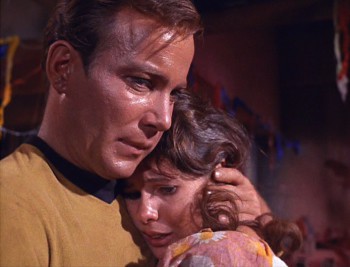
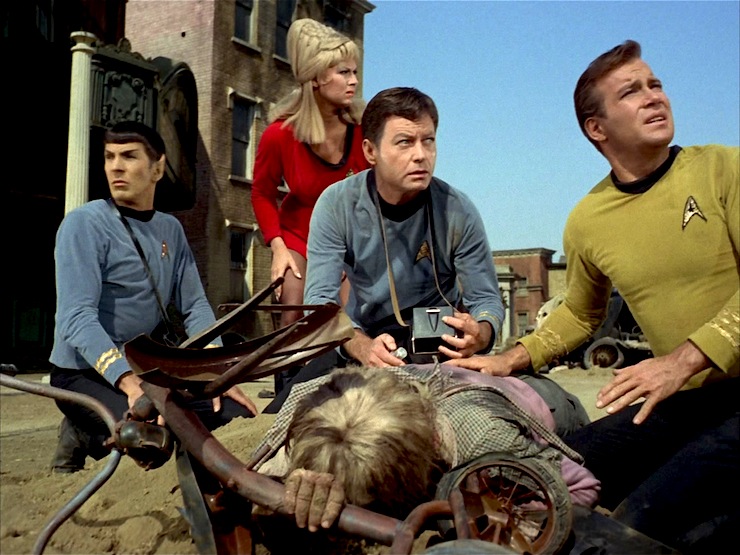
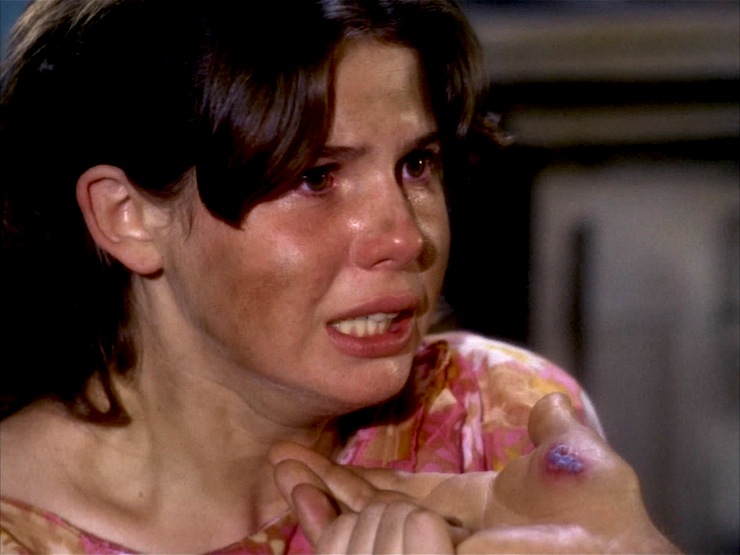
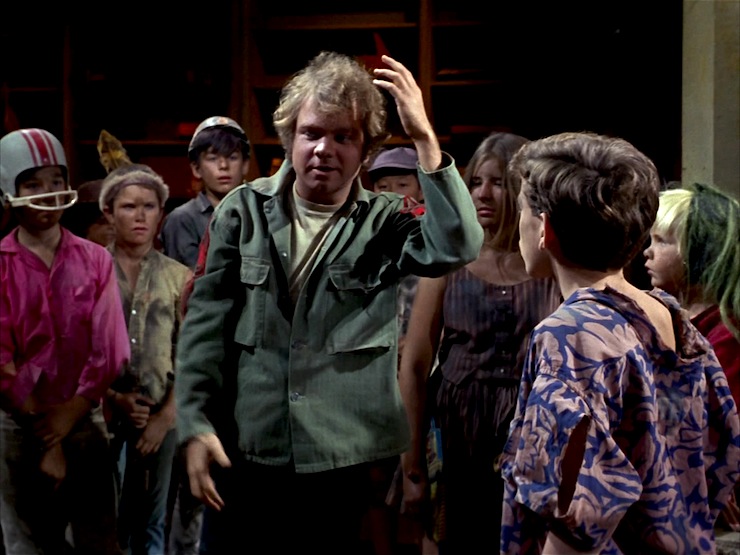

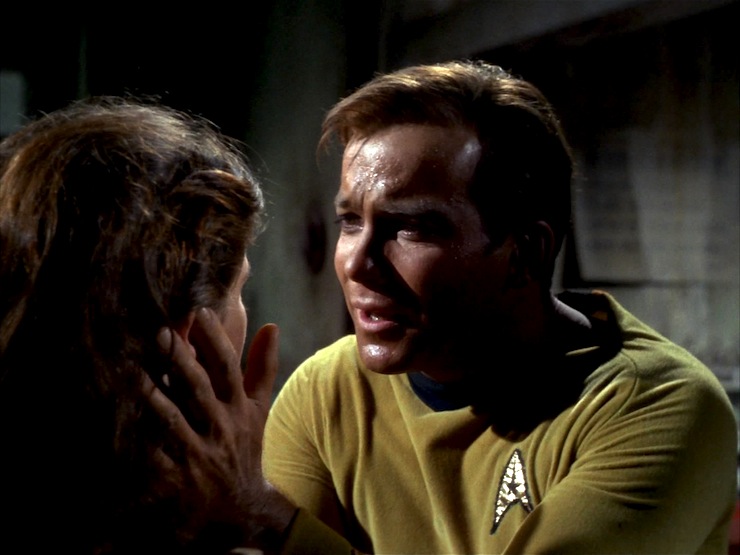
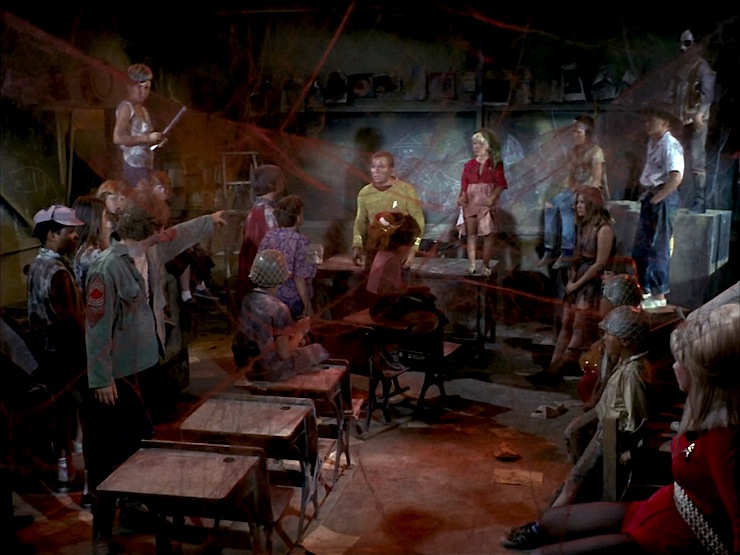
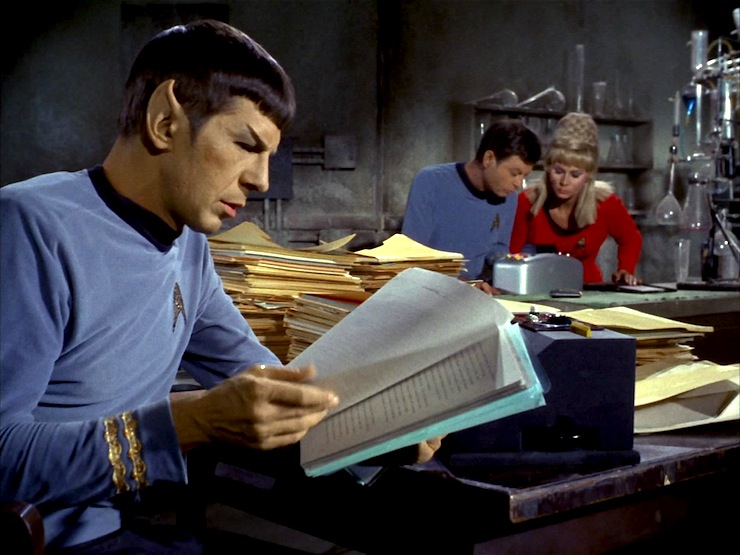
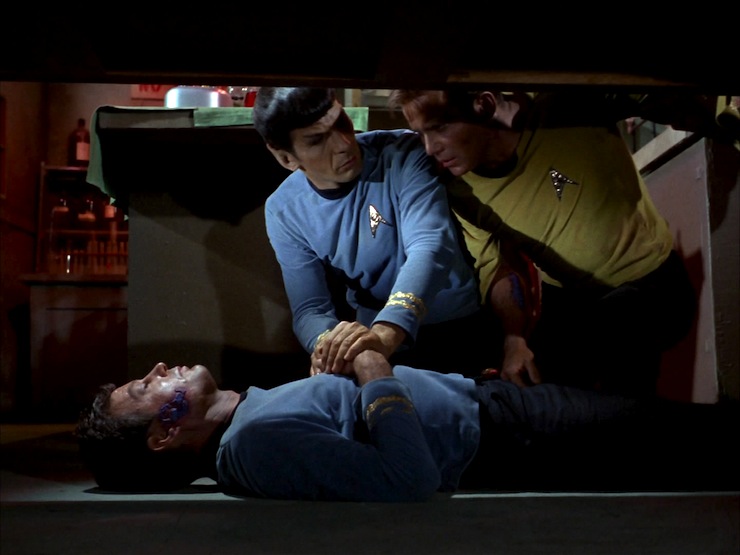
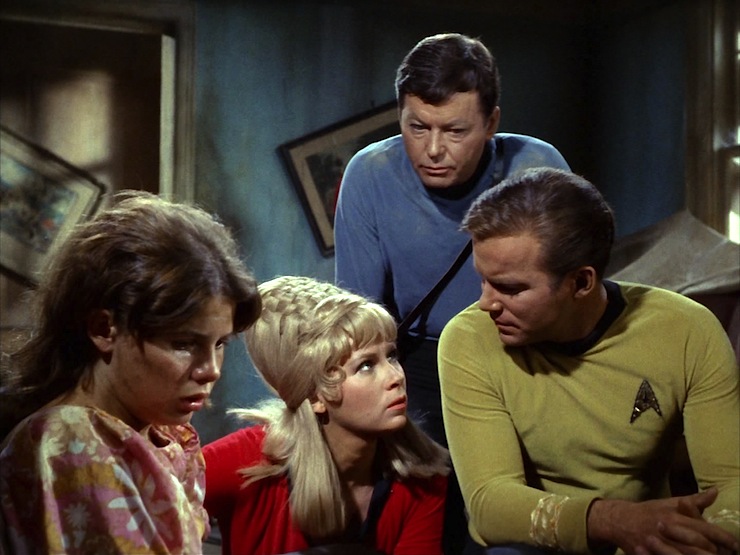
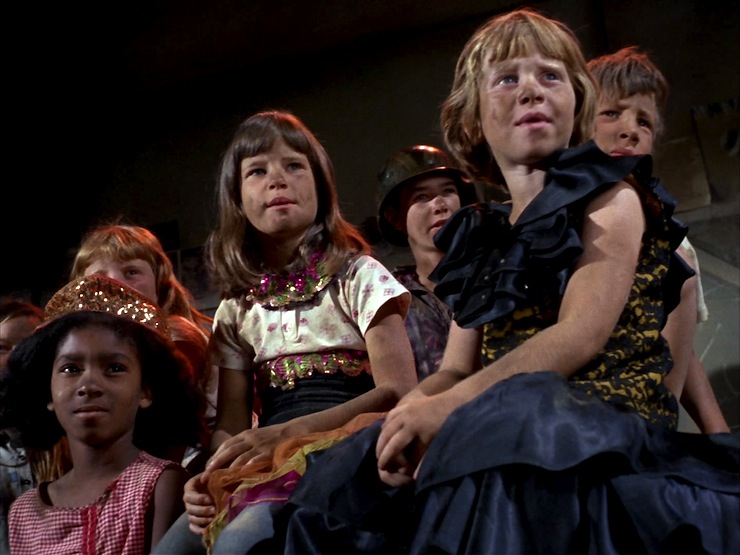
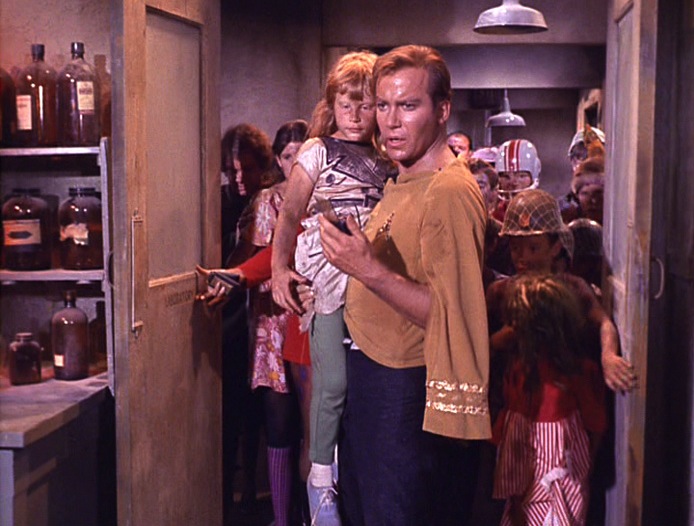
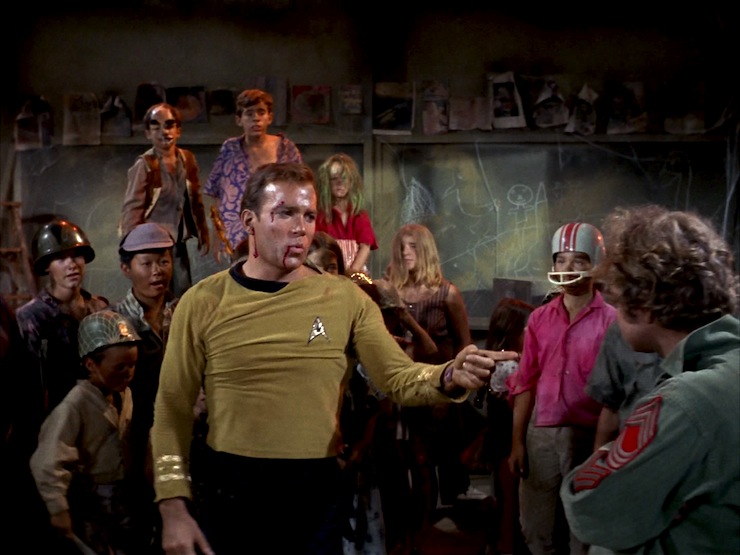
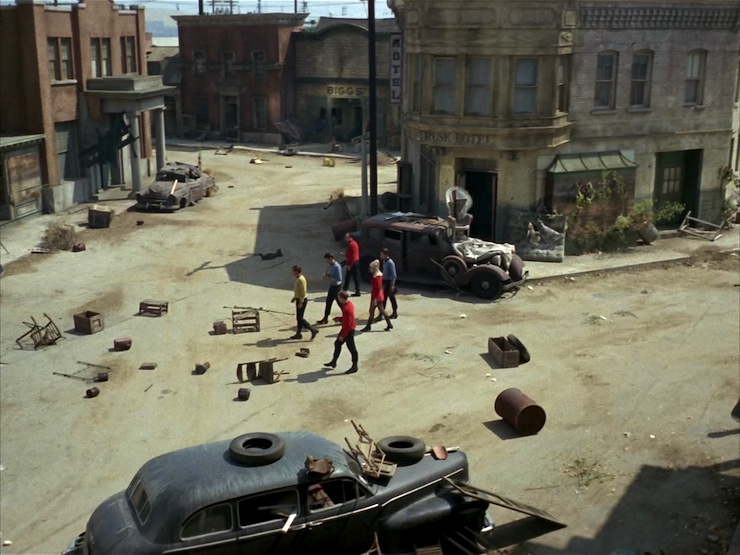
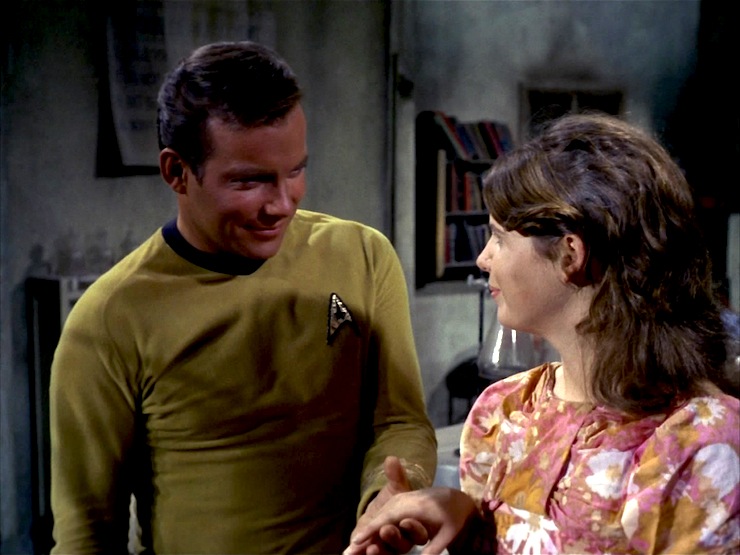
In Forgotten History, didn’t Christopher Bennett explain Miri’s planet as the Earth from an alternate timeline which was somehow displaced into Kirk’s timeline?
Hilarious. And also, yes, that part annoyed me so much about this episode. Surely they could have come up with a better way to have the kids steal/ disable communications instead of having what are supposed to be trained Starfleet officers ALL act with such complete stupidity.
I hate it when a show needs something to happen, and the only rationale is BECAUSE PLOT.
Although, as you noted, Miri ends up being a cougar, it most emphatically does not make it less creepy that Kirk is being skeevy with her in the beginning. He has no idea she’s really 300, and although Kim Darby was 18 or 19, Miri is obviously supposed to be much younger. I’d put the character at around 13, maybe, which is all kinds of NOPE for Kirk to be going after her. Kind of surprised it was allowed on TV back then…although Lolita was on film in 1962, so what do I know?
@1/Usual Suspect – To the Memory Beta databanks! Survey says: yes.
@Keith – I agree with your review, but you really think this rates a point higher than “Dagger of the Mind”?
What I want to know is why the Enterprise didn’t beam down fresh communicators when they lost contact with Kirk and co? They were sending info back and forth pretty regularly, surely someone noticed? I can understand them not beaming down a science or medical team in hazmat suits, because Naked Time showed Starfleet crew were completely incapable of keeping them on properly, but surely a fresh bucket of communicators would not be out of the question?
As for the exactly like Earth problem, I’m going to call it because of quantum. Look, in an infinite universe if something is physically possible then it must occur, so a duplicate earth is theoretically possible, now it could occur anywhere in the universe, but if it can occur anywhere then there is no reason it could not exist really close, and if it must exist and could exist there, then there is no problem with Kirk finding it. See, quantum.
Skeevy Kirk is skeevy, but it was the 1960s and the great sexual awakening was happening, which would go on to cause massive problems within the BBC fifty or so years later. The things people considered acceptable back then are staggering today. A thirty something man flirting with a teenager hardly even registers on the 1960s skeev-o-meter.
If there’s one thing I’ve always enjoyed about this episode, it was Bones being brave enough (or stupid, depending on how you look at it) to test the vaccine on himself.
I’m glad you brought up the glaring omission of the planet resembling Earth. For all we know, that should have been the episode’s plot. Given the original draft supposedly came up 10 minutes short, this may have been Carabatsos’ way of extending the episode. And I know this is television, but by the time the show was over, I was sick of looking at that backlot. At least Vasquez Rocks looks appropriately alien.
Uhura once again absent. No wonder Nichelle felt slighted and considered quitting.
Of course, I had no idea Kim Darby was that famous until I saw the original True Grit in preparation for the Coen Bros. version with Hailee Steinfeld. Pollard on the other hand, what the hell was that? If you’re going to cast kids, cast people who look their age. Pollard looked well over 20 even with a babyish face. At least Darby still looked like a kid, even when she filmed True Grit.
I didn’t think that Kirk was flirting with Miri, more that he cared about her and acted towards her like a father. Whenever I see this episode, I’m sorry the writers never gave him a daughter.
I like it that the children have developed their own language, with words of their own like “grups” and “onlies”.
But I don’t watch this episode much because it’s so depressing – all the dirt and rubbish and the children turning to monsters one by one. It’s more like a horror story really.
And those children are our first parallel humans. Could it be that the parallel earth was actually meant as a (not very good) explanation for the existence of parallel humans and parallel architecture? Something like “It’s not surprising that they look exactly like us because their planet looks exactly like ours, too”?
@1/The Usual Suspect: Yep, that was me. I’ve always found the random Earth-duplication idea here totally ridiculous, but at one point I realized that it was written as though it were a parallel timeline — it’s a 1960s setting that had been stuck in time for 300 years, suggesting a Sliders-like alternate Earth that diverged as a result of the life prolongation experiments. So I came up with the idea of a parallel Earth that somehow slipped into our reality. Now, that wasn’t enough to salvage the episode for me, because it’s still terrible, so for years I just treated the episode as apocryphal. As far as my personal chronology was concerned, it just never happened.
But then, when I was developing Forgotten History, I decided I wanted to do a story about a parallel timeline, and I happened to remember my “Miri” theory. And that got me thinking: How would the history of other worlds have unfolded if humanity had been all but destroyed in the 1960s? What would’ve happened to the Vulcans and Andorians and such with no Jonathan Archer to nudge them toward the birth of the Federation? And the answers I came up with to that question were so interesting to me that it even made it worth acknowledging the existence of a piece of crap like “Miri.” Although I kept any specific references to the episode to a bare minimum.
Because, seriously, this stinks. Keith spelled out most of the problems, but I can name more. In particular, it makes no sense that these 300-year-old people still act like young children. I don’t care how physically immature they are, they’ve got centuries of life experience. They should be more mature as a result. Granted, they wouldn’t have fully matured brains and decision-making capabilities yet — apparently that doesn’t really happen until about age 21 — but there are plenty of kids who are capable of making good decisions or learning ahead of the curve, and surely those kids would’ve outlived the foolish kids who got themselves killed doing stupid things without parental supervision. So really, the survivors should be the smart, sensible, capable, sophisticated ones.
Also, if they’re just these feral children playing games all the time, who the hell feeds them? Did they just happen to have 300 years’ worth of canned foods lying around? How can they farm or fend for themselves if they haven’t learned responsibility? It just makes no sense. Also, the structures wouldn’t have remained intact for 300 years without plenty of maintenance. In Forgotten History, I suggested that there used to be a larger, more self-sustaining population of preadolescents, but they’d been worn away by disease and attrition and famine until it was just these last few feral kids left. Although that still falls far short of making sense of this inane premise.
Honestly, I never liked this episode even before I recognized the logic holes. I found the grup/disease makeup ghastly, and found the story and the setting unpleasant. I never liked Miri or the whole love-triangle stuff or Jahn and the kids or any of it.
Keith mentioned that Blish’s adaptation made Miri’s planet an Earth colony in the 70 Ophiuchi system. What’s also worth noting is that Blish established that the colony had been founded over 500 years earlier and had architecture from the early 2100s — suggesting a time frame for Star Trek of the mid-27th century! (Odd because in his very next volume, in his “Space Seed” adaptation, Blish explicitly put TOS in the 23rd century, making him the first person ever to do so.) Even more interestingly, the colonists fled Earth because of a long period of turmoil called the Cold Peace — which was an event from Blish’s Cities in Flight universe. Yes, in this and other stories, Blish was treating ST as a story taking place within his own SF universe! Which shows how small ST was back then, and how big James Blish was in comparison.
Worth noting that Cry of the Onlies also disregarded the duplicate-Earth idea. You can tell that from the planet’s name in the book, Juram V — the fifth planet of its star, when “Miri” explicitly stated that it was third from its sun. (And Blish made it the fourth planet of 70 Oph.)
Iona Morris was also the original voice of Storm on the ’90s X-Men cartoon (though she was soon replaced by Alison Sealy-Smith — yet reprised the role for the Spider-Man cartoon set in the same continuity.)
@7/Eduardo Jencarelli: Presumably, the reason for the duplicate Earth was to give them an excuse to use the Culver City backlot and a bunch of 20th-century props, and to have human guest stars. It’s interesting to note how few actual aliens (other than Spock) we got in the first half-season. We had the Talosians in “The Cage,” Balok in “Corbomite,” a dog with antennae in “The Enemy Within,” the Salt Vampire in “The Man Trap,” the Romulans in “Balance of Terror,” and Ruk in “Little Girls.” Up to this point, it’s been very much a human-centric universe.
@3 – Miri being actually centuries old only helps a little, as she is just entering puberty and has the emotional maturity of an early teenager. It is still an adult letting a pubescent girl flirt with him.The thing that actually makes it less problematic is that Kirk genuinely wants to help her and the other kids and was mostly trying to win her trust and get intelligence on the situation by the shortest route available not anything perverse.
I understand wanting to use available studio resources, but the implication is you had a bleeding edge medical research laboratory operating behind a Mayberry storefront on this world, which also had a transmitter with power of some sort good for 300 years.
My favorite weird thing about this episode was the pencils.
Kirk needs something to distract Miri, so he has her sharpen, like, a million pencils, which no Starfleet crew member has EVER EVER been seen using, even in this episode, where they handle huge stacks of paper files but only write with styluses.
They are clearly Dixon Ticonderoga #2s. It’s like somewhere on the Enterprise, someone is going to need those suckers for the SAT.
On the whole “flirting with a teenager” thing… It should be remembered that in the ’60s, the assumption was that every woman’s goal in life was to attract a good husband, get married, and become a mother. Even women in the workplace were assumed to be using their employment as an opportunity to meet and attract prospective husbands. So in a sense, being attractive and marriageable was seen as a woman’s job. So — while there were certainly some men who were sexual predators — for most men, telling a teenage girl that she was pretty and desirable wasn’t about trying to seduce her or get her in bed; it was simply being complimentary and encouraging, telling her that she had what it took to succeed in life and should feel good about herself. It was the equivalent of telling a boy that he was smart or strong or a hard worker.
So while there are certainly all sorts of sexist and marginalizing and false assumptions underlying the attitude, it wasn’t generally predatory in the sense it would be seen as today. It would’ve been perceived (at least by the men) as simply being complimentary and encouraging.
My major malfunction with these kind of episodes is that there isn’t any fallout from it. Yes, its ’60s TV, but even TNG is guilty of it too. There aren’t any consequences in the larger world.
McCoy, who by all accounts is one of the best/greatest doctors in Star Fleet/the Federation, creates a cure for a disease that lets you age one month a century and thats it? Where is this medical miracle ever seen again? Shouldn’t everyone be immediately given this disease (and its cure)?
Not my favorite episode, although I second Keith’s praise for Kim Darby.
“Beaker Full of Death” would be one helluva name for a garage band, if it isn’t already.
@13/Ragnarredbeard: The disease slowed aging in preadolescents only, remember. It wouldn’t have done adults any good. And I suppose the implication was that once the children were cured, they would’ve resumed aging normally. At least, that’s what I’ve always assumed, though the episode doesn’t seem to state it.
Still, you have a point. Even if the experiment failed, the developers got halfway there. They succeeded in achieving life prolongation for children, just not for adults. So if further research had been done to identify and correct the flaws in the process, maybe a successful life prolongation formula could’ve been developed. Just one of the many sci-fi inventions that got abandoned after the first failure rather than refined and made viable. (See also the Genesis Device, soliton-wave propulsion, and numerous others.)
@14/MikePoteet: There’s a poster on The TrekBBS whose username is “A beaker full of death.” It was years before I realized what it was an allusion to, because I really hate this episode.
Am I the only one who just found Kim Darby annoying and whiny here? I’ve never liked her voice.
What’s the point of a vaccine when everybody on the planet is already infected?
I’ve updated the entry to include not only Christopher’s Forgotten History but also the comic book Untold Voyages #3 by Glenn Greenberg, Mike Collins, & Keith Williams, which is also a sequel to this episode.
Jose: what can I say, I thought this had more redeeming features than “Dagger of the Mind.” *shrug* If I did this rewatch three months from now, I might pick different rankings, but both are, basically, deeply flawed episodes redeemed only by some good performances.
Jana: really? I don’t see Kirk’s attitude as even remotely paternal.
—Keith R.A. DeCandido
@15 CLB
Well McCoy *did* live until at least his 130s, so you never know… ;)
Thanks for the mention, Keith!
Funny thing is, my story didn’t start out as a sequel to “Miri”–it was originally supposed to be much closer to what D.C. Fontana had in mind for “Joanna,” the episode she wrote about McCoy’s daughter, which was heavily rewritten to become “The Way to Eden.”
I kept the main kernel of Fontana’s idea–Bones and Joanna are reunited and there’s a brief flirtation with the notion that she and Kirk are going to become romantically involved, which puts a strain on Kirk and Bones’s friendship. But as I worked on the story some more and tried to make it as McCoy-centric as possible, I decided that the main plot would be about him being held responsible for a deadly plague on a planet he visited years before, the population of which he thought he had saved. And “Miri” seemed like an ideal choice.
By the way, in my story, I established that Miri had died, which apparently pissed off legendary comic-book writer/artist John Byrne. I guess that’s SOME kind of accomplishment! :-)
Glenn Greenberg
@7: If you think Pollard’s presence in this is ridiculous, you should see the Lost in Space episode he did where he plays a kid who’s apparently the same age as Penny (and this is a first season episode, so she’s only about 13). It’s actually one of the few episodes of the series that can unironically be called good.
And then two years later he was nominated for an Oscar in Bonnie and Clyde.
@9/Christopher: Yes, it’s a human-centric universe, and most of the alien species we do encounter are really alien. It stays like that for a while – The Conscience of the King is human-centric, so is Court Martial, The Galileo Seven has stone-age giant apes, and later in this season there’s the Gorn, the Horta… In the second and third seasons, we get less human colonies and more parallel human aliens.
@17/Keith: Yes, really.
When they find Miri in that closet, she’s terrified, so he smiles at her, tries to comfort her, tells her nice things to put her at ease. Later he gives her little jobs to do (cleaning a desk, sharpening pencils) so that she can feel useful. At one point he sends her away (“Take Miri for a walk”) before talking about adult stuff like diseases and viruses with Spock and McCoy. He doesn’t even realise that Miri has a crush on him, thinking instead that “children have an instinctive need for adults”. He does smile at her a lot, but he gives that exact same smile to Spock in one scene, so we can conclude that it means nothing but friendship.
He doesn’t seem to be attracted to Rand either, although he used to be in earlier episodes. When she has her nervous breakdown, he merely comforts her. (He’s probably still madly in love with Noel :-)). That’s what he mostly does in this episode – smiling a lot, comforting everyone, while McCoy and Spock do the actual work.
Am I the only one who sees it this way?
@15/Christopher: Actually, her voice is one of the things I may like best about her performance. It’s tremulous when it is called for, confident at other times, dead-on hurt young woman when appropriate (“Mr. Lovey-Dovey,” just before the other kids take up the refrain)… To each his own, of course, but I think she delivers a very nuanced and capable performance. I have no trouble accepting her as a centuries-old person in a young woman’s body. I know she’s not supposed to come off that way, exactly – as you astutely pointed out in an earlier comment, all these “kids” should have picked up something from centuries of life experience – but it works, somehow, for me. The magic of acting. Acting! Genius! (apologies to Jon Lovitz).
@22/Jana: I don’t think I see Kirk in this episode quite as you do, but I don’t see him as “skeevy” either, exactly. I mean, some moments come really close – the ones Christopher singles out @12; Christopher, you are no doubt right about the 1960s context mitigating them, but I still have trouble viewing them charitably – but I don’t think he ever crosses the line into “leading her on,” as they say; and I also don’t think he fully appreciates what an effect he’s obviously having on Miri. Which is all sorts of weird in itself, too – here’s our male lead hero, so blissfully unaware of his power to make the girls swoon… I dunno. It’s a strange episode, no matter which way you slice it.
I had never had the thought about his apparent lack of attraction to Rand, but that’s a good catch. (If I were Kirk, I’d still be madly in love with Helen, I know that much.) The whole “look at my legs” bit is so awfully patronizing, and yet Grace Lee Whitney plays it so very well – yet more of this episode’s whole weirdness. I get this was probably meant as Roddenberry’s idea that everyone could be a sex object in the liberated age; and, as I understand it, the miniskirts did feel empowering to at least some women in the 60s – didn’t Grace claim they were her idea, or she at least really lobbied for them to be as short as possible? – but… The best I can do with that scene is, once her attraction to Kirk is above board and on the table, that is pretty much the end of her career on the Enterprise, because the two of them can’t have a relationship like that while he is her superior officer. So it contributes to a nice enough “in universe” explanation for her departure. (What really happened is despicable and tragic, and I’m so glad she was able to work through and rise above it, even though her road was very long and painful. Rest in peace.)
Another random thought: I’d love to see this episode remade (with more plausible science and circumstances all around) as a TNG adventure, given Picard’s discomfort around kids! Can’t you hear Sir Patrick’s dulcet British tones, “No! No ‘blah blah blah!'” :)
It’s been a while since I watched this episode, but I think sexual politics of the 1960s allowed for both interpretations simultaneously. I mean, as I recall even a fairly progressive show like TOS sometimes infantilized its women. The fact that this might have been considered more ‘normal’ then doesn’t make any of it less creepy now.
Michael Pollard playing a young teenager was hilarious when I saw this though!
I’d say Colin nails it. Especially given the time period….
—Keith R.A. DeCandido
This is one of the episodes I saw as a kid (wow, did my folks have any idea what I was watching in those days?). Yes, it is a horror story if you see it just from the kids POV. The horrible monster attacks them but he’s really a kid. He’s upset about his tricycle. Then, he dies.
As a kid, I remember that horrible image. A child with almost nothing left, dying in a dying world, with one toy he’s held onto and treasured from back when the world was safe. He may or may not know he’s dying. I’ve always assumed the kids drove off or attacked anyone showing signs of the disease. Now, adults have arrived–people who could help him or offer some kind of protection (all right, they’re too late for him. But, like I said, kid POV), and seeing them only makes him feel more threatened and attacked. The last thing he has is being taken from him. I’ve always hoped he felt some kind of safety there at the end when he had his trike back.
You get the horrible picture of what these kids have been through. They’ve seen their parents go insane, attack them, and die. For 300 years, the oldest kids–the leaders who are holding things together–have, one by one, gotten the same disease, gone through the same transformation, and died. For all we know, the kid with the trike was the leader a week ago. On some level, the kids know they’re dying but all they can really do is hold onto denial, to see the infected as “other,” drive them away, and pretend it’s not going to happen to the rest of them.
On one level, I don’t see why they stopped their attack on Kirk (the decision really should have been on screen). On another level, their leader may have just taken over after the kid he’s followed for 300 years died (or after the latest in a succession of kids he’s followed for 300 years died). He’s trying to be confident but he knows he’s probably next. Like the rest, he’s been traumatized and seen plenty of death. But, there’s still enough of a kid inside him–and he’s still new enough to being in charge and terrified by what he knows being in charge means (under the denial and bravado, he knows he’s going to ultimately fail, become a monster, turn on the kids he’s supposed to be leading if they don’t drive him out, and die alone)–that he wants an adult who can show up and fix things. He wants to hand over the job that’s been given to him and have everything be all right.
Or that’s what I remember deciding when I was younger.
I maybe put a lot more into these episodes as a kid than they deserved, but that’s part of being a kid.
I didn’t quite figure out why the place was just like Earth. I figured I’d missed something. I tended to mix up all the SF I knew and thought the Enterprise was (sorry, have to say it) Lost In Space when I first started watching it (“five year mission” apparently didn’t mean much to me or I thought they’d been lost five years, I’m not sure). Anyhow, they finding worlds like Earth only to find out they weren’t Earth (lost colony probably made sense) worked just fine for me.
I got that Miri liked Kirk but not much more. Of course, I probably thought the difference between thirteen and collecting social security was negligible back then.
Oh, and because it has to be asked, who’s giving the kids regular haircuts?
This is also part of the ongoing trope where kids who appear on Trek are innocent-evil, like Charlie X. I assume the writers’ favorite things to read were The Veldt and Lord of the Flies.
I think this idea that there were nearly-exact “Earth parallels” all over the galaxy, for no particular reason, was explicitly stated in the series bible (as an economizing measure, of course). The later Trek series mercifully pretended it never happened, though, of course, the galaxy was still full of approximate humanoids.
This wasn’t the only episode where Earth-parallelism was treated as a matter-of-fact thing with no story explanation; “The Omega Glory” is my personal least favorite (and the premise has a lot in common with “Miri”, come to think of it: once again, it’s a run-down, post-apocalyptic society whose inhabitants have mysterious longevity somehow associated with disease).
When I saw this episode in my ongoing, mostly-chronological watch/re-watch of the Star Trek franchise I was struck by how this story is a twisted version of Peter Pan, with Lost Boys, a love/crush triangle, and Kirk in the position of a Peter Pan who is actually subverting the eternal youth of the children.
Has anyone else noticed this?
@23/Mike: Miri in TNG – that’s a great idea! I would love to see Picard giving a speech to the children, trying to win them over despite being uncomfortable among them. Also I’d hope they’d bring along Deanna Troi – I can imagine her filling Kirk’s shoes just fine, comforting Miri and telling her to grow up and not be afraid… so no fit of jealousy this time.
@26/Ellynne: Yes, that’s what I was thinking – how can they ever achieve a stable society when all their leaders become monsters and die?
My daughter wants to see the episode because Miri looks so cute in the DVD menu, but I really don’t dare showing it to her.
I agree with the flaws everyone’s pointed out in this episode, but for whatever reason it’s always more or less worked for me. I think I sort of read it as really being about growing up and leaving childhood behind, how scary that can be, and how reluctant people sometimes are to do that. That might not be a legitimate reading of the episodes themes, though — I could be making it up. *shrug*
Normally, the planet being an identical Earth would really bother me, but I never actually remember that when I think of this episode. It just never stuck in my memory. Go figure.
-Andy
@27/Matt McIrvin: Yes, indeed. While Roddenberry tried to make ST relatively plausible and well-researched compared to most prior SFTV, he did include the very fanciful idea of parallel Earths as a way to convince the network executives that the show would be affordable to make, since it would allow reusing props, costumes, sets, backlots, etc. from historical and contemporary productions. (For instance, “A Piece of the Action” was written specifically to take advantage of leftover paraphernalia from Desilu’s The Untouchables.) TNG and its contemporaries used the holodeck for much the same reason.
I’ve had the thought that maybe it would’ve been better if Roddenberry had had the idea to do Sliders instead of Star Trek — have the parallel worlds literally be alternate Earths in other timelines, rather than alien planets that somehow happened to recapitulate our history or be subjected to some form of alien meddling.
TNG did touch on the idea of parallel development a bit, but not with humans; the Mintakans in “Who Watches the Watchers?” were a parallel to the Vulcans in a lot of ways. I found it appropriate that in a universe that had Earth parallels, there would be parallels for other planets/species as well.
@30/AndyHolman: I forgot about the duplicate-Earth angle for a long time myself, perhaps because I didn’t watch the episode that often and because Blish and The Cry of the Onlies elided it, and because the episode itself essentially abandons it after the teaser. In fact, I’m kind of wondering if maybe the syndicated version that was available when I was growing up cut out the opening scene. Once in high school (or in a summer program for high school students), I overheard a kid playing an audiocassette recording of the teaser of this episode (yes, I am that ancient), and I could not recognize what episode it was. Even though I could usually identify a TOS episode within the first ten or fifteen seconds.
I wish I was fast enough to post about things before you all jump in! Lol I check fairly often but with Keith’s schedule and commitments it’s hard to know when the post is up then boom!, when it is, 30+ comments !! Lol
So just to add mine to the pile, wow Kirk, hitting on a teenager…just wow. Creepy indeed!
I haven’t seen Sliders, so this is not a knock on that property; but Star Trek, while it has its parallel dimension and alternate timeline moments (and many of them are outstanding), is something we could, theoretically, one day really do as a species and a society. We could really and truly go out there to the final frontier. Can we really and truly visit alternate dimensions and timelines? Well, evidence less clear, at best. I’m not saying parallel dimension and alternate timeline stories have nothing to teach us, or don’t make fascinating thought experiments; but, for me at least, they don’t have the same aspirational quality as space sf, from the hard stuff to grand space opera (some of which, I grant, is just as unlikely… though I would still dearly love a lightsaber!).
@19 – Glenn: Sorry, but almost everything pisses off John Byrne. :)
@33/MikePoteet: Well, sure, not denying that. I’m just saying that Roddenberry’s clever idea of using parallel Earths as a way to make a sci-fi show affordable would’ve been a better fit for a concept like Sliders than it was for a space-travel series — if only because you wouldn’t have to choose between either coming up with corny explanations for the duplication (cultural contamination of an imitative people, Nazi-glorifying historians, ancient-astronaut Greenpeace, Greek-cosplaying aliens) or just putting it out there without justification (random duplicate Earth, space Romans, space Declaration of Independence). It would be a more natural, less awkward premise in that context.
Not that he really had much choice but to use it, given 1960s production realities. Although maybe there were other options. The series could’ve been set much further in the future and relied on the trope of long-lost Earth colonies recreating the cultures and fashions of their origin world, sort of Battlestar Galactica in reverse — much like what Blish did in his “Miri” adaptation. Or maybe they could’ve come up with the holodeck idea a decade early, though that has its own drawbacks. (Yes, one decade, not two, since the first holographic rec room appeared in the animated episode “The Practical Joker” in 1974.) And there was the trope they actually did use several times, of advanced aliens creating replicas of historical settings or items drawn from the crew’s minds (e.g. Trelane, the Shore Leave planet, the Melkot, the Excalbians). Although there were so many Earth history-obsessed aliens already that I wouldn’t have been crazy about more.
Or here’s a thought — even though ST was a space-travel series, it didn’t shy away from other subject matters like time travel or parallel universes. They made time travel a fairly frequent thing after it first appeared, so maybe they could’ve done the same with parallel-reality travel, as a supplement to their regular mission profile. Like maybe after “Mirror, Mirror,” they could’ve done a followup in which a scientist devised a way to duplicate the reality-crossing effect, and then they could’ve brought that scientist back as a recurring catalyst for subsequent dimension-hopping episodes. Although that wouldn’t have helped with “Miri” any.
@35/Christopher – I think we’re on the same page, Christopher! I wasn’t out to argue with your point; it just got me thinking (and that’s a good thing!). It got me wondering why I’m not more drawn to stories of alternate history and other dimensions. I was just musing “out loud.” :)
I think Trek’s trope (ha, try saying that three times fast) of aliens drawing things from characters’ memories is actually one I really like, and I hadn’t stopped to think about it until just now. That’s why, for example, “Specter of the Gun” can have it’s (I think) really cool, fragmentary, surrealistic look (I know the reality of the budget, but I think it works to that episode’s advantage).
(Comment deleted by its author)
@37/pen_pals: Thank you for seeing the episode the way I do!
I’m with CLB on this; I can’t stand this episode. I never cared for Miri, either, and the whole feel of the episode is weird and unpleasant. I grin and bear it because it’s Grace Lee Whitney’s last full episode. Beyond that, there’s just nothing to redeem this for me, made worse by Uhura not being in this for no apparent reason. Kim Darby did nothing for me here; I could take her or leave her; the Kirk-Miri dynamic always makes me wince; and the “onlies” are creepy and invoke no sympathy for me.
I wish Grace Lee Whitney could have had a better episode for her farewell performance. I don’t know the details of why she left (I’m sure Keith will cover this in the next rewatch) but I wish we could have gotten to know Rand better. Sadly this is Rand’s last substantial role in any Trek episode or movie.
Just been thinking about those “After man” specials on the History channel, and how fast nature reclaims cities after human beings stop cutting the grass and killing the weeds. Or look at the villages around Chernyobol after only 20 years. (Logan’s Run kind of came close with its version of Washington DC.) There’s no way Miri’s city would look as good as it did after 300 years with no grups doing maintenance.
I think Miri is supposed to be around 16 or 17 and anyway it’s not like Kirk was trying to bang her, he was just being nice and trying to win her over because she was the only voice they had that the snot nosed kids would listen too. But speaking of age, using cousin Virgil for an older adolescent seems like a big stretch and if anybody seems to give off a pedo vibe he does. But when are people going to admit as far as physical attractiveness goes a female usually peaks between 16 and 20, it’s just the truth. Now I’m not saying it’s ok to court a girl that age if you are 10 years older because it’s not ok. As a teen you’re still very impressionable and are too easily persuaded by some creepers.
Not one of my favorites.
@41/Rreal: I agree that Kirk was just being nice. He didn’t even notice that Miri had a crush on him, he thought she stayed close to them out of loneliness or curiosity or because “children have an instinctive need for adults”. As for her age, she was supposed to be on the verge of puberty. This means she could have been anywhere between 10 and 15. But of course she was really around 300 anyway.
“a female”?
@12 ChristopherLBennett:
Not to mention the age standard for minors being involved in romantic relationships in the US was previously much lower than it is now.
When my grandparents were born in the 1920s, most girls would have had at least one baby by the time they had reached the age of about 12 or 13 unless they were sterile.
There is still no minimum age of marriage in 18 US States if parents give consent to marriage. In Tennessee, girls as young as 10 years of age have been married with parental consent as recently as 2001.
I am not defending this practice. I was simply making a point that it was once very common and expected for children to be romantic relationships.
@22/JanaJansen,
Not only do I see this episode (Kirk’s behavior here) the same way you do, but I interpreted “No beach to walk on … ” to not be specifically directed at Rand, but an expression of a general longing.
Of course Miri was in the extremely unusual situation of coming into her awareness as a sexual being (and even more, with a need for real love and a loss of interest in childhood games) in the absence of any other suitable partners. In that context I saw Kirk as simply acknowledging her womanhood, without having any actual sexual intentions.
@46/Keleborn: Yes, I agree. And I like that they revisited that longing in “The Paradise Syndrome” and Generations.
My question: Where’d they get their food and water? Kirk tells them they’ve eaten all of the canned food, but that would have gone bad centuries earlier.
The kids’ immaturity might have been psychological. They looked like kids even though they knew they were much older, so they acted like it. It also sounds like their names might have become corrupted over the centuries-“Miri” for Mary, “Jahn” for “John.” Also: If it was a true parallel Earth, did they have counterparts with their descendants on the original? Maybe even among the crew?
@48/mspence: “Kirk tells them they’ve eaten all of the canned food, but that would have gone bad centuries earlier.”
He only tells them that “the food’s all gone”. We don’t know how it was preserved. Also, food in cans doesn’t spoil for a long time. There are examples of fifty or a hundred year old canned foods that were still edible.
@48/mspence: See my comment #9 about how I explained Miri’s world in Forgotten History. I figure they weren’t always like this, that these are the last survivors of what used to be a more functional society of “children.” After all, the buildings are way too intact for 300 years of total disrepair and neglect.
All attempts to build an actual society must have been doomed by the fact that the eldest and most responsible children became monsters and died. Over and over again.
@51/Jana: Maybe, but the point is, they must have had a somewhat functional society for most of the past 300 years, in order to feed the populace, maintain the buildings, repair the clothes, etc. It’s nonsensical to posit that they’ve been completely feral for that long yet still remain alive with their buildings and clothes mostly intact. That just wouldn’t work. It’s almost as stupid as positing that 300-year-old people would still act like preadolescent children despite centuries of life experience. So I prefer to see it less as “perpetual childhood” and more as the end result of a long downslide into chaos and feral behavior.
@52/Christopher: Yes, that’s what I meant. After the initial trauma of seeing all adults go mad and destroy things and each other, they may have done fairly well for a while, but it couldn’t last because the illness would always take the most capable of them. It was bound to become a long downslide.
A comment on the parallel-Earth business. In the Shatnerverse novels (I forget which one) some exposition described this planet as one of several Earth-duplicates that had been discovered by the Federation, and noted that they had also discovered a handful of duplicates of other worlds, including Qo’noS and other core Federation planets. It was heavily implied to be the deliberate (if mysterious) work of the Preservers. I don’t like all of the continuity proposed by this series, but I always was intrigued by that particular idea.
@54/tjareth: I hate the way writers ascribe godlike powers to the Preservers. The only thing they’re canonically established as doing is relocating one small population to a planet in the middle of an asteroid field and putting one lousy repulsor beam generator in their temple to “protect” them. So not only did they not demonstrate the slightest hint of technological ability beyond the 24th-century Federation at most, but they’re really pretty damn incompetent at their job. Also, their only documented act occurred no earlier than the 17th century, since Native American populations wouldn’t have been in danger of extinction before then, nor would they probably have existed in a form Spock could recognize. So it’s bizarre that people need to perceive them as some incredibly ancient, all-powerful space gods. I see them more as a sort of space Greenpeace. (I still say the best candidates are the Vians from “The Empath,” who had the exact same type of mission.)
Being that Robert Kirkman’s “The Walking Dead” became such a hit it would be interesting to take this concept and develop it (long before the arrival of the Enterprise 300 years later) as an ongoing series. The early couple of years’ of the surviving children trying to cope with what happened to their world and most importantly themselves.
In the scene where Kirk is attacked by the “children”, one can’t help thinking about the book, Lord of the Flies. Even though this wasn’t anywhere close to the brutality of Piggy’s death from that story, Kirk emerging all bloodied at the hands of the “children” was still pretty disturbing.
I also wonder if Miri had a counterpart on Earth in the twentieth century, since this does seem to be a parallel Earth from another timeline, and if she might have had descendants, perhaps even a female one in the Enterprise crew. It could have been an interesting subplot if Kirk met her…
JJ: “I didn’t think that Kirk was flirting with Miri, more that he cared about her and acted towards her like a father.”
–Same. The only real weirdness comes from viewers whose emotional range is so stunted they see all affection as sexual, somehow. Ugh. Oh, and it’s obviously, crassly heterosexist.
The parallel Earth business was an idea that went awry and wasn’t sensibly deleted. It doesn’t add anything, though I suppose among its original motivations was rendering plausible the idea that viruses jump species based on some sort of common biological foundation. Still, the blunder of a parallel Earth that adds nothing to the tale should have been caught and deleted.
Overall, though, it’s really only the fourth act, with Kirk and the children, that doesn’t work. He’s only half way to convincing them to return the communicators (whose return proves unnecessary after McCoy’s bravery) when we CUT to Kirk leading the children and the communicators to the makeshift medical office.
Even so we have Darby’s extraordinary performance, unlike anything, really, on serial tv. The gang of children manage to be all of focused, menacing, vicious, playful, and vindictive in short order. Spock is variously earnest, charming, wry—such a pity that so many directors, writers, and actors got Vulcans so very wrong (in the context of Nimoy’s multifaceted performance) in future incarnations.
One of the most unfortunate was Jolene Blalock’s interpretation of T’Pol, which (along with Connor Trineer limited skills) did more than anything else to sink Star Trek: Enterprise with four years of stone faced, tight lipped line delivery. Blalock is a charming performer when allowed or motivated to act. What a pity it was decided to interpret the role in a way opposite her considerable talents. (Don’t believe me? Watch the couple of ST ENT episodes where she cuts loose. She’s impressive.)
We also have children who are the opposite of easy, lazy interpretations of childhood ubiquitous in serial tv of the time. It was a helluva gamble for the series, and impressive, to say the least, that ST TOS got a bloodied Kirk past NBC standards and practices division.
“I like it that the children have developed their own language, with words of their own like “grups” and “onlies”. “
–Agreed. This is quite well done, but not overdone. It’s difficult to get right, and they got it right.
“But I don’t watch this episode much because it’s so depressing – all the dirt and rubbish and the children turning to monsters one by one. It’s more like a horror story really.”
–The horror story portion is another aspect often missed. These children are indeed monstrous, even murderous. That was so well done they couldn’t then successfully pull off Kirk persuading the pack to become humane. Most of the way through Act 4 I was thinking, ‘how on Earth are they going to pull this off? There’s no way they can get Kirk out of the hole the writers dug for him. The kids as depicted are too far gone to be convincingly brought to some kind of sanity—or even plain rationality—in the time remaining,’ and of course, they couldn’t, so the writers and rewriters—-who included Adrian Spies outline, then his original teleplay, followed by his gratis rewrite, a staff polish, then back to Spies for more work, then his next free rewrite, his draft in response to yet more notes, John D.F. Black’s rewrite, Black’s script polish, Gene Coon’s rewrite, then further rewrites by Coon and Roddenberry—-pulled Kirk as far as they could, but the hole was too deep. I’d bet an intermediary scene was filmed in there, and it just didn’t work, so they shrugged and cut.
It’s difficult to persuasively write children of means as nasty, even vicious, but they pulled it off.
So, sure, there’s a lot to justly criticize, but it’s a surprisingly interesting, largely well wrought hour. As for minor issues, a few edits are jarring. In a couple of cases when we cut the music immediately comes at full volume. The timing (170 hours!) before the disease becomes critical, deadly, is an obvious stretch to get a hard clock running, and it’s scarcely credible. In one closeup of Rand the lighting is painfully overwrought and distracting—not the first or last time Finnerman would do this. And McCoy successfully trying the vaccine on himself makes recovering the communicators meaningless or at least irrelevant.
Definite problems, but there are some fine performances from Darby, Nimoy, and Kelley, and Shatner does a respectable job in his most thankless episode yet.
@59/Blair Schirmer: “The parallel Earth business was an idea that went awry and wasn’t sensibly deleted. It doesn’t add anything, though I suppose among its original motivations was rendering plausible the idea that viruses jump species based on some sort of common biological foundation.“
Unlikely, since they had no problem with the idea of humans and “Vulcanians” interbreeding. It’s simply that they wanted an excuse to use the New York street backlot and 20th-century props rather than having to spend money to build an alien environment. Although later on, they often used the backlot for alien planets without trying to justify it, as in “The Return of the Archons.”
“Miri” is one of the dreariest episodes, though its premise was interesting. Keith cited some of the logical fallacies on this planet (and I would add, just how have these children survived for hundreds of years without any visible means of food production?). And while ”Mudd’s Women” is widely condemned for its sexism, Yeoman Rand’s behavior here is beyond the pale. From showing Kirk the lesions on her breast to saying how much she always wanted him to “notice” her legs, this is the very bottom of female degradation on the show. The actress who played Miri was fine (I think she would later appear in ‘True Grit” with John Wayne), but the other kinds – especially Jahn and the bonk-bonk boy – were annoying as hell.
Blair Schirmer, Jana Jansen, Keleborn … thank you. I too have never seen anything creepy in Kirk’s attentions to Miri. Our culture is way too oversexed–I mean, way too quick to associate sexual, and often negatively sexual, connotations to everything. If you really consider them, Kirk’s compliments and attentions to Miri never went beyond what any good father modeling gentlemanly behavior to his “little girl” might do. It was definitely a different sort of relationship than he carried on in some of his, er, “adult” romances.
I also have a different take on Yeoman Rand showing Kirk the lesions on her body.
First of all, whether one wants to admit it or not, women, at least some women, have always wanted men to notice their physical charms and attributes. This is just part of the way the sexes are wired; like anything else in life, it can be a good thing or a bad thing, and is best employed with keen moderation. Being down on this planet, infected with “the disease”, Kirk and Rand as well as the others were in a tense, life-or-death situation, and not being the writer or producer or the television viewer, had no assurance that they would come out of it alive. In such situations, there may be things that people want to share with each other–things that they never could say before– there may be an intimacy they want to share with each other–one that does NOT necessarily have to be totally, maybe even partially, sexual in nature! There can be many factors involved–the medical, the physical, emotional, spiritual, relational, etc. And our reactions/ responses in these situations are not always perfect, but we may be doing the best that we can at the time.
Anyway, this is the way I see it. Thanks for listening/ reading.
I’ll also join in and say I don’t find the Kirk-Miri thing really creepy. Lots of girls first crushes are on grown men, and there’s nothing really inappropriate in how Kirk handles it in the episode. Obviously lines have been crossed in the past, and this kind of thing is hard to pull off, but while this is hardly the best attempt, there’s nothing really bad about it.
Two things drive me crazy about this episode: the unexplained mirror image of earth setting, and the kids are just plain annoying. It’s just wild that it clearly looks like earth, they note that it’s virtually identical to earth, and that’s all you hear of it. Happens all the time. It’s a very diverse universe, except the parts that are exactly the same. As for the kids, they just come across as annoying. I’m not sure what the right answer to how to play such a thing is; maybe it’s just not a great idea, maybe it just wasn’t fleshed out right, I don’t know.
It’s not the worst episode, but it’s just clumsy overall, with just a few interludes worth watching. I give it a warp factor 3.
The kids all acting so infantile, despite being hundreds of years old pretty much ruins the episode for me. Not to mention the other myriad gaps in logic concerning food and the like. It’s unfortunate because if it had been more thought out they could have created some interesting characters. What would a person with hundreds of years of experience but with the brain chemistry of a child actually be like?
There’s also plenty of fridge horror here. The lives of these kids are terrible to comprehend. Their lives on the planet were awful of course and terribly long only to be suddenly cut short, but their cured lives are also a disturbing inverse of our own. We have, typically, short childhoods and long adulthoods, but these people will spend centuries as children, a good portion of which was spent in that weird semi-perception before the age of four, and now that they are cured will have a comparatively brief adulthood. And it’s unlikely those adulthoods will be very happy ones, considering how long and terrifying their childhoods were.
In this episode Lt Farrell tells the stricken Kirk on the planet “I’ve got volunteers standing by ready to help you.” I was intrigued by this – I wondered how The Enterprise chose “volunteers” for what was believed to be a suicide mission?? Did they simply “ask” for volunteers? Or did they draw a lottery? Or did they pick crewmen (and women) who were single and childless? Or maybe they had a “suicide team” all ready for just such an emergency? It was also unclear to me if Farrell was in charge of the ship – with Kirk and Spock on the surface and Scott and Sulu nowhere to be found.
As Grace Lee Whitney was raped by an “executive” after this episode was filmed, it makes her near-rape scene in “Enemy Within” even more cringe-worthy and unbearable to watch. I have all the compassion for Grace and it must have been bizarre for her to watch reruns of herself on ‘Trek’ knowing what she had to endure. As for the ”executive” that raped her, I have my suspicions of who it was, but I do not wish to speak ill of the dead. In any case, ‘Trek’ should have treated her better and given Yeoman Rand a more developed character.
Now my reaction is that this is a dumb plot point that went nowhere. But as a kid I was really impressed!